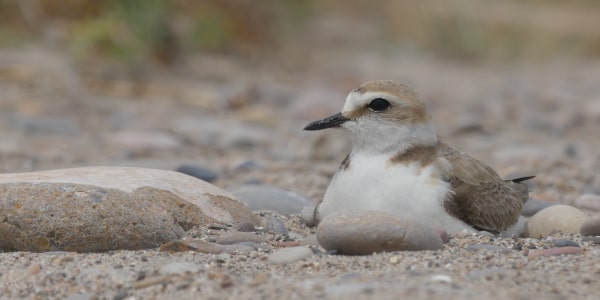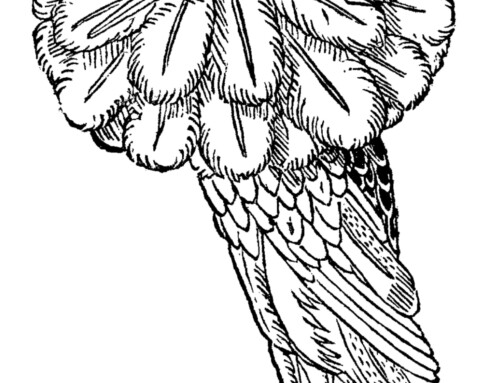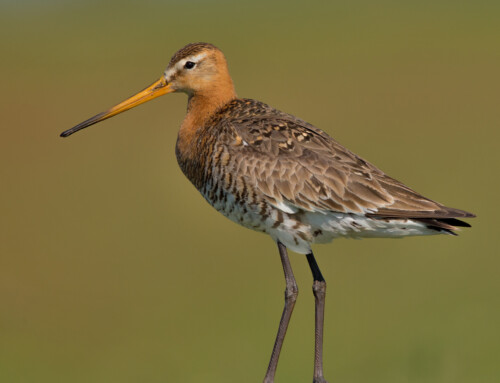LINKED PAPER
Four‐legged foes: dogs disturb nesting plovers more than people do on tourist beaches. Gómez‐Serrano, M.Á. 2020. IBIS. DOI: 10.1111/ibi.12879. VIEW
Recreational activities have increased disproportionately in recent decades in natural areas, and beaches are probably one of the most appreciated natural spaces for leisure. Beaches support a higher level of human disturbance than other ecosystems, so efficient management of these natural areas is essential to maintain ecological processes and the conservation of coastal wildlife. In this context, coastal shorebirds are excellent models to study the direct and cumulative effect of human disturbance on bird fitness and survival.
In order to estimate how the impact of human presence affects breeding birds on beaches, the behaviour of incubating Kentish Plover (Charadrius alexandrinus) was studied in relation to approaching people, vehicles and dogs. To this end, observational data were collected and control experiments were performed with a standardized stimulus, within the framework of a long-term study of the consequences of human disturbance on Mediterranean Spanish beaches. The response variability of birds in the decision to flush from the nest was studied depending on the type of beach user, the location of the disturbance event and thermal stress. In addition, nest return time at the end of disturbance was studied.
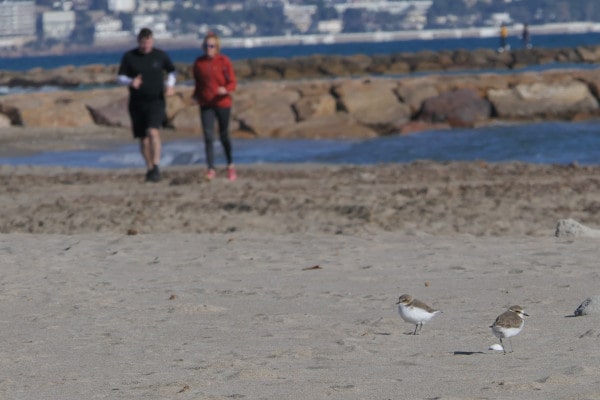 Figure 1 Joggers approaching to Kentish Plovers on a beach © Miguel Ángel Gómez-Serrano
Figure 1 Joggers approaching to Kentish Plovers on a beach © Miguel Ángel Gómez-Serrano
The results of this research have shown that there is a disproportionate response of birds depending on the location of the disturbance, and especially when dogs are present. For instance, walkers, when accompanied by dogs, flushed plovers 93.8% of the time when walking through dunes and 80.0% of the time when walking on paths, whereas pedestrians alone flushed plovers 47.6% of the time when in dunes and only 12.9% of the time when on paths. Nevertheless, lone dogs triggered a flushing response 100% of the time when they roamed the dunes and 50% on the shore.

In fact, dog walking is one of the most popular recreational activities worldwide, and beaches are one of the natural environments in which dog walking occurs most frequently. Nevertheless, there is a lack of evidence on the impact of dogs on wildlife, which is often used by dog-friendly groups lobbying against pet control in natural areas. The results of this study highlight the need to regulate the presence of dogs on beaches.
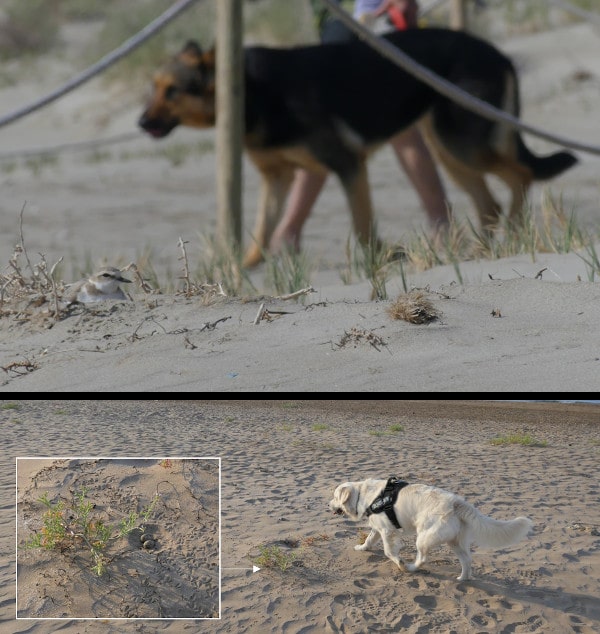 Figure 3 The upper picture: Kentish Plover female incubating the nest on a beach frequented by people and dogs. The nesting area is closed by an exclusion fence, a management measure that facilitates the habituation of the birds to the stimulus of human disturbance. The bottom picture: a lone dog wanders very close to an active Kentish Plover nest © Miguel Ángel Gómez-Serrano
Figure 3 The upper picture: Kentish Plover female incubating the nest on a beach frequented by people and dogs. The nesting area is closed by an exclusion fence, a management measure that facilitates the habituation of the birds to the stimulus of human disturbance. The bottom picture: a lone dog wanders very close to an active Kentish Plover nest © Miguel Ángel Gómez-Serrano
Disturbance causes thermal stress to birds
It was observed that flushing behaviour of plovers was affected by the ambient temperature, so that the incubating birds flushed less at higher temperatures. In the same way, nest return time decreased as ambient temperature increased, so that birds returned faster to incubate in situations of greater thermal stress. These results, similar to those observed in tropical beaches (Yasué & Dearden 2006), must be understood in a context of a trade-off between the risk of nest predation and clutch thermoregulation. The exposure of bird eggs to solar radiation on hot days may cause overheating in a short time. In the studied beaches, the breeding period of the Kentish Plover coincides mainly with high temperatures that can be lethal to unattended eggs.
Sex differences in flushing behaviour
In this survey, females flushed more frequently (57.1%) than males (32.0%) in response to disturbance events. Consistently, females returned later to the nest after approach experiments. These results suggest that there should be a different risk perception between sexes. Indeed, this bias in gender risk perception towards the disturbance stimulus has been documented in phylogenetically distanced species (Frid & Dill 2002). The results of this study suggest that males may have a lower risk perception and greater tolerance to stress caused by the disturbance stimulus. Nevertheless, in a previous study of the same plover populations, it was found that the investment in nest defence (distraction displays towards a standardized disturbance stimulus) was different within the couple, with a greater investment of females (Gómez-Serrano & López-López 2017). Differences in defence investment between sexes are frequent among birds, but females normally risking more, according to their greater reproductive investment (Montgomerie & Weatherhead 1988).

Habituation is the key to the coexistence between birds and tourism
The study was carried out both on beaches subject to human disturbance and on others with restricted access to people. The behaviour of the birds was different according to the level of disturbance of the beaches, since nest return times after flushing experiments were shorter on disturbed beaches, suggesting habituation to the human disturbance stimulus.
As mentioned above, the ambient temperature for the nests in which plovers flushed was lower and nest return time decreased proportionally with ambient temperature, both suggesting that habituation to the human disturbance stimulus encourages relaxation of the trade-off between escape behaviour to avoid predation risk and the effects of thermal stress on unattended eggs.
The main findings of this study suggest that one of the most effective management measures to reduce the impact of human activity is to establish buffer between nesting areas and people, which can help birds habituate to the predictable and non-lethal stimulus of human presence, facilitating coexistence between conservation and recreation. This space-time concurrence between birds and leisure is one of the main conservation challenges of coastal ecosystems, which requires an understanding between local, economic and natural environment managers. It is clear that the exclusion of one of the two uses (environmental or recreational) has costs not assumable for the two sectors, so both are called to understand each other and the conflict must be resolved through a long-term sustainable coexistence model.
References
Frid, A. & Dill, L. 2002. Human-caused disturbance stimuli as a form of predation risk. Conservation Ecology 6: 11. VIEW
Gómez-Serrano, M. Á., & López-López, P. 2017. Deceiving predators: linking distraction behavior with nest survival in a ground-nesting bird. Behavioral Ecology 28: 260–269. VIEW
Montgomerie, R. D. & Weatherhead, P. J. 1988. Risks and rewards of nest defence by parent birds. Quarterly Review of Biology 63(2): 167-187. VIEW
Yasué, M., & Dearden, P. 2006. The effects of heat stress, predation risk and parental investment on Malaysian plover nest return times following a human disturbance. Biological Conservation 132(4): 472-480. VIEW
Image credit
Featured image: Kentish Plover Charadrius alexandrinus female © Miguel Angel Gómez-Serrano


